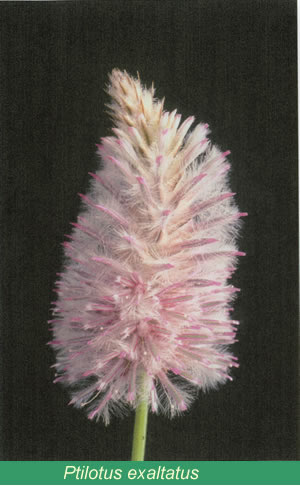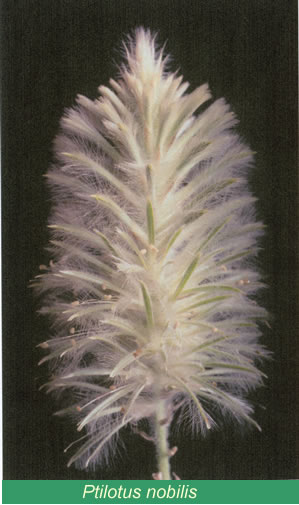

Summary of final report on the Australian Flora Foundation funded project:
Peter Abell and John Oates
Plant Breeding Institute, Faculty of Agriculture, University of Sydney, NSW 2006
Grant Details Final Report
Ptilotus spp. have ornamental appeal. They exhibit a range in plant form from prostrate/trailing through erect herbs to small shrubs. Leaf colour varies from bright green to silver/grey. Flower colour is usually pastel shades of pink, mauve, green, pale yellow and also white. They are however most striking due to the numbers of flowers produced and the size of the inflorescence. The overall floral display is often enhanced by long scapes presenting the inflorescence on or above the plant.. This variation provides plant form and foliage contrast not found in existing landscape species. This all points to a group of plants that if adapted to horticulture could fill a range of floristry needs.
There are 116 accessions in the PB1 collection covering thirty two species. Sixty seven were collected from their natural habitats with known provenance details.
The germination rate of extracted seed was far more reliable than that achieved from sowing the flower/seed bulk, and both soft tip and semi-hardwood cuttings have been used successfully to produce clonal replicates. Plants of several species have proven to be quick to establish and are quite hardy in the field. Even considering the recent drought, the field plantings required very little supplementary water. The best performers at this stage are P. obovatus., P. exaltatus, P. nobilis, P. calostachys and P. polystachys.
P. clementii, P. polakii, P. ledifolia, P. macrocephalus, and P. rotundifolins were weak growers in the field.
Initial trials on vase life were very encouraging. Inflorescences from 7 species were cut and placed into distilled water. All lasted at least 14 days, with P. polystachys maintaining condition for a full 7 weeks (49 days).
So far, all attempts at controlled crossing have failed. Simple experiments attempting to germinate pollen on artificial media are inconclusive. A better understanding of the reproduction biology of Ptilotus spp. is needed to ensure success in future attempts at deliberate hybridization.
